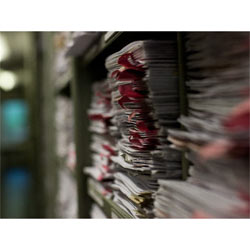
Richard Ehrlich is a humanist. Not necessarily because he does two things quite well--practice medicine and make art—that are long entrenched in popular notions of celebrating humankind. It is rather because he happens to tap the actual sense of that term: an effort to understand, authenticate, communicate that which is uniquely human. This includes seeking and creating beauty, order, cohesion, while acknowledging the potential for its opposite.
This month Ehrlich is the subject of concurrent exhibitions. The images at the Laband Gallery comprise the older series and are to this reviewer the more lasting and powerful. This is not because they deal with the bleeding heart subject of the Holocaust, not at all, but by virtue of the way they recall the persistence of human order and human horror in equal parts, and in a flat footed yet aesthetically seductive fashion. Newer works at Craig Krull indicate a willingness to take risks across varied media and subjects, as well as an instinctive understanding of humanism as defined above.
Ehrlich saw an ad about a building appropriated from an old Luftwaffe bunker that was designated to hold the records meticulously kept by the Reich of Holocaust victims exterminated at the various death camps. As Germany reconciled this aspect of its history, it seemed wrong to destroy the rooms and rooms of records chronicling minute details on cards written in tight Teutonic script of, say, how many lice a former Jewish professor had in his hair when he was gassed. The idea was that family could perhaps find information, scholars could undertake research, and that in some sense the archive might stand as an anti-monument in the sense Malcolm Miles uses the term, to mean the opposite of commemoration, as a committing to collective memory.
We have all time and again seen the photographs of stacked bodies, the vacant eyes of skeletal prisoners. Because in a digital age we are inundated constantly with Photoshop-ed images of horror from locales such as Sudan and Myanmar, these shots of Nazi camps begin to feel like they do the opposite of what they intend--to record genocide—and instead somehow end up playing into the hands of Holocaust deniers.
What Ehrlich smartly did was see an opportunity to speak about this time in history from a step away. He will tell you he is not particularly drawn in any way to the Jewish cause and did not intend to proselytize (which may be one reason why these are such effective statements). In this distant positioning Ehrlich actually chronicles the completeness of the atrocity in a way that leaves one breathless. The large sepia-toned images might well be conceptual kin to the 224 photograph series of “Water Towers” by Bernd Becher and Hilla Becher--row upon row of files simply recorded from angles that sweep up and back into the distance with a quiet here-ness.
The stark storage rooms make for these rather remarkable conceptual photos that, beside everything else they do, question the very possibility of the neutral photograph, or the neutral history narrative. The images are large enough and fine enough that you are drawn in. Once there, you begin to make out small cryptic details on file labels, on documents that make evident what it is you are looking at: thousands upon thousands of names of the killed, lists of property on arrest, lists of weight on death. Further, the filing cabinets and stark walls come to us via the artist’s terrific intuition as clean Modernist grids--that zenith emblem for some universally ordered and democratically distributed world. We confront an irrefutable fact of human indecency on a proportion that the mind cannot fully grasp through the trope of distance and beauty. I venture to say there is not one survivor who would say this approach neutralizes the crime. Quite the opposite.
Ehrlich is a man passionate for information, remarkably well versed in the history of photography and believing that all his images should stand--or hang--in their own right. However, the mystery and frailty of the human condition is an organizing theme still rumbling in the background of the newer work at Craig Krull. Here Ehrlich “optimizes”--the artist’s term---slices of imagery taken by cutting edge MRI and CAT scan technology. At its most sophisticated, this technology is able to record up to 600 cross sections of internal organs/minute structures/designated body parts, then reconstitute these into “a chest,” “a head,” such that a physician can digitally peel back and see each layer selectively simply by keying in coordinates. It is how Ehrlich selects these views that makes for the art. Details like the tangled coil of the aorta, or the vascular system feeding the deepest recesses of the brain, float in images which at their best are luminous and beautiful, and offer the merest suggestion of human anatomy, yet convey a sort of incandescent and insistent life force.
The more subtle the images, the more powerful the impact. The very literal outlines of the cranial skull hovering in this sort of isotopic, radioactive hue can look a bit like super excellent skateboard design. It is shocking to see that these amorphous structures inside all of us are so very striking--in the Kantian sense of that which, separate from logic, understanding, function duty can elicit that “ahhhhhh” of pure visual pleasure. The eventual realization that what we are viewing aesthetically is in fact no more than our plumbing, that it is working or failing us for the duration of our four score years, and that these “shapes” are responsible for sight, touch, pleasure, breath, pain and death only deepens the experience.
Published courtesy of ArtScene ©2009
